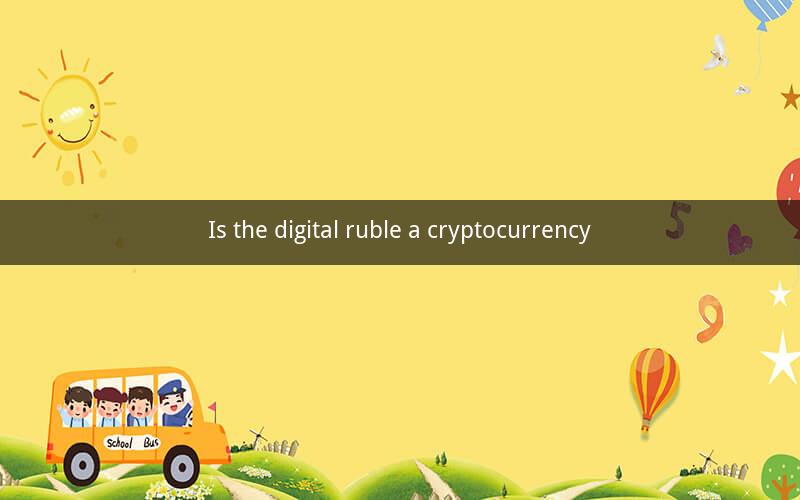
Is the Digital Ruble a Cryptocurrency?
Table of Contents
1. Introduction to the Digital Ruble
2. Understanding Cryptocurrency
3. Comparing the Digital Ruble and Cryptocurrency
4. The Benefits of the Digital Ruble
5. The Challenges of Implementing the Digital Ruble
6. The Future of the Digital Ruble
7. Conclusion
1. Introduction to the Digital Ruble
The digital ruble, also known as the digital currency, is a digital currency issued by the Central Bank of Russia. It is designed to complement the traditional ruble currency and to facilitate digital transactions. The digital ruble aims to provide a secure and efficient means of payment for both individuals and businesses.
2. Understanding Cryptocurrency
Cryptocurrency is a digital or virtual asset designed to work as a medium of exchange. It uses cryptography to secure transactions, control the creation of new units, and verify the transfer of assets. Cryptocurrencies are decentralized, meaning they are not controlled by any central authority.
3. Comparing the Digital Ruble and Cryptocurrency
While the digital ruble shares some similarities with cryptocurrency, there are significant differences between the two.
Centralization: The digital ruble is issued and regulated by the Central Bank of Russia, making it a centralized currency. On the other hand, cryptocurrencies are decentralized and operate on a peer-to-peer network.
Regulation: The digital ruble is subject to strict regulatory oversight by the Central Bank of Russia, ensuring compliance with existing financial regulations. Cryptocurrencies, on the other hand, are not subject to the same level of regulation, which can lead to concerns about security and legal compliance.
Security: The digital ruble utilizes advanced cryptographic techniques to ensure the security of transactions. Cryptocurrencies also use cryptography to secure transactions, but there have been instances of security breaches and theft in the cryptocurrency space.
4. The Benefits of the Digital Ruble
The digital ruble offers several benefits over traditional and cryptocurrency alternatives.
Accessibility: The digital ruble can be accessed by anyone with a smartphone or computer, making it more accessible than traditional banking services.
Security: The digital ruble provides enhanced security features, such as multi-factor authentication and blockchain technology, to protect against fraud and theft.
Efficiency: The digital ruble can facilitate faster and more efficient transactions compared to traditional banking methods.
Inclusion: The digital ruble can help include unbanked individuals and businesses in the formal financial system, providing them with access to financial services.
5. The Challenges of Implementing the Digital Ruble
While the digital ruble offers numerous benefits, there are several challenges associated with its implementation.
Adoption: The digital ruble may face resistance from traditional financial institutions and consumers who are accustomed to using cash or credit cards.
Technology: Implementing a secure and scalable digital currency requires advanced technology and expertise, which can be challenging for the Central Bank of Russia.
Regulation: The digital ruble must comply with existing financial regulations, which can be complex and time-consuming to navigate.
6. The Future of the Digital Ruble
The future of the digital ruble appears promising, with several potential developments on the horizon.
Integration: The digital ruble could be integrated with other digital currencies and payment systems, facilitating cross-border transactions.
Innovation: The Central Bank of Russia may continue to innovate and improve the digital ruble, making it more secure and user-friendly.
Global Adoption: The digital ruble could potentially gain international recognition and adoption, making it a more viable alternative to traditional and cryptocurrency alternatives.
7. Conclusion
The digital ruble is a digital currency issued by the Central Bank of Russia, designed to complement the traditional ruble currency. While it shares some similarities with cryptocurrency, there are significant differences between the two. The digital ruble offers several benefits, such as accessibility, security, and efficiency, but also faces challenges in adoption and implementation. The future of the digital ruble appears promising, with potential developments that could make it a more viable alternative to traditional and cryptocurrency alternatives.
Questions and Answers
1. Q: What is the primary difference between the digital ruble and cryptocurrency?
A: The digital ruble is issued and regulated by the Central Bank of Russia, making it centralized, while cryptocurrencies are decentralized and not controlled by any central authority.
2. Q: How does the digital ruble enhance security compared to traditional banking methods?
A: The digital ruble utilizes advanced cryptographic techniques, such as multi-factor authentication and blockchain technology, to secure transactions and protect against fraud and theft.
3. Q: Can the digital ruble be used internationally?
A: The digital ruble could potentially gain international recognition and adoption, but it is currently designed for domestic use within Russia.
4. Q: What is the potential impact of the digital ruble on the traditional banking industry?
A: The digital ruble may disrupt traditional banking by offering more accessible, secure, and efficient payment solutions.
5. Q: How does the digital ruble ensure privacy for users?
A: The digital ruble provides enhanced privacy features through the use of advanced cryptographic techniques and secure transaction protocols.
6. Q: Can the digital ruble be used for purchasing goods and services online?
A: Yes, the digital ruble can be used for purchasing goods and services online, as well as for other digital transactions.
7. Q: Is the digital ruble subject to inflation?
A: Like the traditional ruble, the digital ruble is subject to inflation, which is controlled by the Central Bank of Russia.
8. Q: How does the digital ruble compare to digital wallets?
A: The digital ruble is a digital currency issued by the Central Bank of Russia, while digital wallets are software applications used to store and manage digital currencies, including the digital ruble.
9. Q: Can the digital ruble be converted to other currencies?
A: The digital ruble can be converted to other currencies through authorized financial institutions or currency exchange platforms.
10. Q: Is the digital ruble compatible with mobile devices?
A: Yes, the digital ruble can be accessed and used on mobile devices, as long as the user has a compatible app or digital wallet.